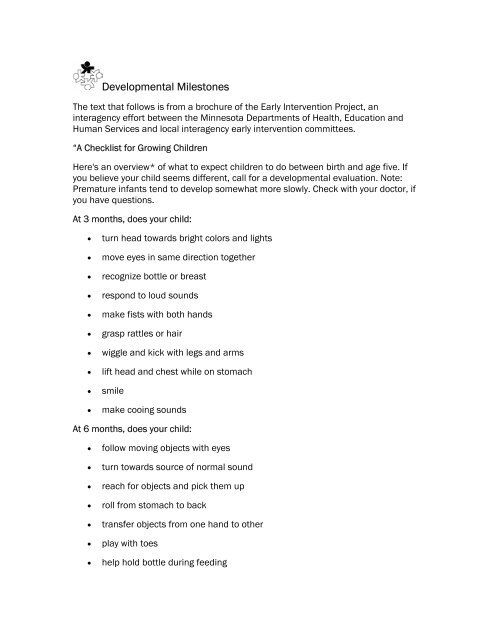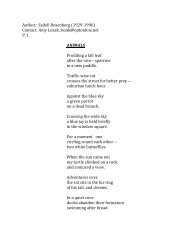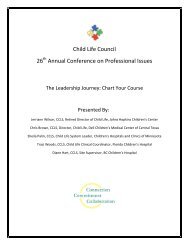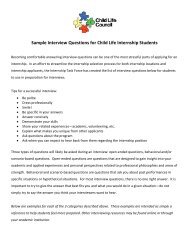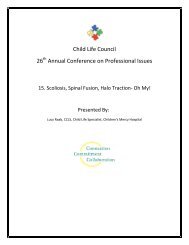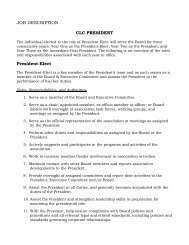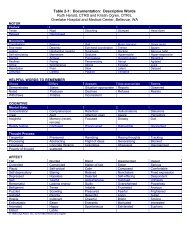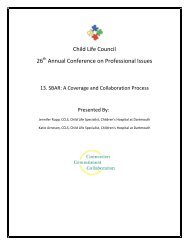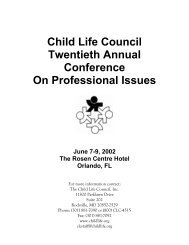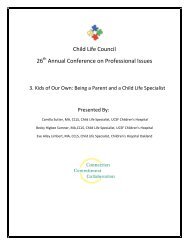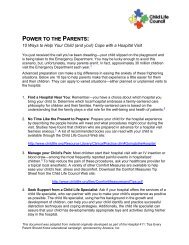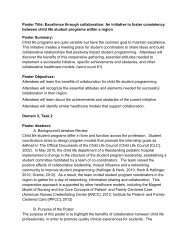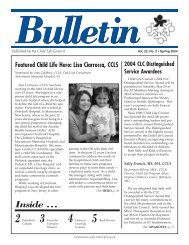Developmental Milestones Pamphlet - Child Life Council
Developmental Milestones Pamphlet - Child Life Council
Developmental Milestones Pamphlet - Child Life Council
Create successful ePaper yourself
Turn your PDF publications into a flip-book with our unique Google optimized e-Paper software.
<strong>Developmental</strong> <strong>Milestones</strong><br />
The text that follows is from a brochure of the Early Intervention Project, an<br />
interagency effort between the Minnesota Departments of Health, Education and<br />
Human Services and local interagency early intervention committees.<br />
“A Checklist for Growing <strong>Child</strong>ren<br />
Here's an overview* of what to expect children to do between birth and age five. If<br />
you believe your child seems different, call for a developmental evaluation. Note:<br />
Premature infants tend to develop somewhat more slowly. Check with your doctor, if<br />
you have questions.<br />
At 3 months, does your child:<br />
• turn head towards bright colors and lights<br />
• move eyes in same direction together<br />
• recognize bottle or breast<br />
• respond to loud sounds<br />
• make fists with both hands<br />
• grasp rattles or hair<br />
• wiggle and kick with legs and arms<br />
• lift head and chest while on stomach<br />
• smile<br />
• make cooing sounds<br />
At 6 months, does your child:<br />
• follow moving objects with eyes<br />
• turn towards source of normal sound<br />
• reach for objects and pick them up<br />
• roll from stomach to back<br />
• transfer objects from one hand to other<br />
• play with toes<br />
• help hold bottle during feeding
• recognize familiar faces<br />
• babble<br />
At 12 months, does your child:<br />
• sit without support<br />
• pull to a standing position<br />
• crawl on hands and knees<br />
• drink from cup<br />
• enjoy peek-a-boo and patty-cake<br />
• wave bye-bye<br />
• hold out arms and legs while being dressed<br />
• put objects into container<br />
• stack two blocks<br />
• have a 5-6 word vocabulary<br />
At 18 months, does your child:<br />
• like to pull, push and dump things<br />
• follow simple directions ("Bring the ball")<br />
• pull off shoes, socks and mittens<br />
• like to look at pictures<br />
• feed self<br />
• make marks on paper with crayons<br />
• use 8-10 words that are understood<br />
• walk without help<br />
• step off low object and keep balance<br />
At 2 years, does your child:<br />
• use 2-3 word sentences<br />
• say names of toys<br />
• recognize familiar pictures
• carry an object while walking<br />
• feed self with spoon<br />
• play alone and independently<br />
• turn 2 or 3 pages at a time<br />
• like to imitate parents<br />
• identify hair, eyes, ears and nose by pointing<br />
• build a tower of four blocks<br />
• show affection<br />
At 3 years, does your child:<br />
• Walk up steps alternating feet<br />
• ride a tricycle<br />
• put on shoes<br />
• open door<br />
• turn one page at a time<br />
• play with other children for a few minutes<br />
• repeat common rhymes<br />
• use 3-5 word sentences<br />
• name at least one color correctly<br />
• use toilet<br />
At 4 years, does your child:<br />
• balance on one foot 4-8 seconds<br />
• jump from step<br />
• dress and undress with little help<br />
• cut straight with scissors<br />
• wash hands alone<br />
• play simple group games<br />
• ask questions beginning, "What Where Who"
• give reasonable answers to basic questions<br />
• give first and last names<br />
• show many emotions<br />
At 5 years, does your child:<br />
• skip using feet alternately<br />
• catch a large ball<br />
• bathe self<br />
• dress alone<br />
• speak clearly<br />
• count five to ten objects<br />
• draw a body with at least five parts<br />
• print a few letters<br />
• copy familiar shapes (square, circle, triangle)<br />
*This checklist was originally printed in the Early Intervention Services brochure for<br />
the Martin County Special Education Cooperative in Fairmont, MN.<br />
Not all kids are cut out to develop the same way. Some can't wait to get help. A little<br />
extra help now might make a difference later.<br />
The story of Sandy<br />
Sandy's mother suspected that her baby didn't have normal hearing. She didn't<br />
respond to voices or loud sounds. Although her family doctor couldn't find any<br />
abnormality in her ears, her parents took Sandy to an ear specialist where special<br />
testing showed a large hearing loss. Equipped with hearing aids, Sandy received<br />
special training in signing and language skills. At five years old, Sandy is speaking<br />
well. She goes to school with all of the other children from her neighborhood. Sandy's<br />
mom says, "If Sandy had not had the program as an infant, we would not have known<br />
how to work with her and those early months would have been lost. She would have<br />
been much more handicapped than she is.”<br />
The story of Michael and Matthew<br />
When Matthew and Michael were born, their parents realized they would both need<br />
help. Matthew has spina bifida and Michael has cerebral palsy. With help from<br />
county and human services, the family received nursing and respite care in their<br />
home. Physical therapy was sometimes held in the backyard, with neighborhood kids<br />
taking part. The boys took community karate lessons to improve their motor skills,<br />
and they now attend a regular community preschool. Their mother says, "Recently a
new professional began working with the kids and said, `I just can't believe how well<br />
they look and how functional they are.' Everyone who works with them comments on<br />
that. Not only was intervention at an early age important, but the support to our<br />
family has been crucial to their development."<br />
The story of Danny<br />
In the first few months Danny's mother realized he wasn't doing the same things her<br />
other two children had done at the same ages. She called the school district for<br />
information. A variety of professionals assessed Danny, then confirmed that he had a<br />
significant developmental delay - a condition where some babies develop skills more<br />
slowly than others. An individual educational plan was written and a special ed team<br />
came to their home once a week. They worked with Danny and his parents to teach<br />
him to sit in a high chair, to feed himself, to play and to develop skills similar to other<br />
children his age. His mother says, "I'm so glad we've been able to work and learn<br />
right along with him at home. In the beginning I felt alone and frightened, but now<br />
we've met other parents in the same situation and they've been very supportive."<br />
The story of Molly<br />
Molly is a child with Down's Syndrome. When she was two weeks old, she was<br />
enrolled in an infant stimulation program. During the weekly visits of an occupational<br />
therapist, Molly's mother learned many ways of working with Molly to improve her<br />
muscle movement and coordination. Now six years old, Molly is mainstreamed into a<br />
normal first grade class with only a little help. She is learning reading and math skills<br />
once thought impossible for a child with her handicap. Molly's mother comments, "I<br />
know that my child made remarkable progress because help was made available so<br />
early. I was taught things I never would have thought of that helped to improve<br />
Molly's speech and motor skills. I believe strongly that every young child with a<br />
disability and his/her family should be offered the kind of help we had.”<br />
The first step: screening<br />
Not all babies do the same things at the same ages. If your child is not developing at<br />
the same rate as others or is not doing several of the activities on the checklist abive,<br />
don't wait. Call your family doctor, medical clinic or the (local health department).<br />
What services are available for young children and their families<br />
If your child is eligible, many early intervention resources can be found in your local<br />
community. When possible, these services are in the home or in community settings<br />
such as day care, early child family education or nursery schools, where parents can<br />
participate. Services can include: respite care, public health nursing services,<br />
physical therapy, occupational therapy, speech/language therapy, early childhood<br />
special education services, special equipment, family support activities and training<br />
for parents.”


